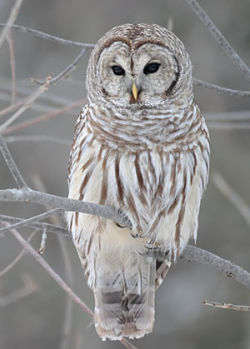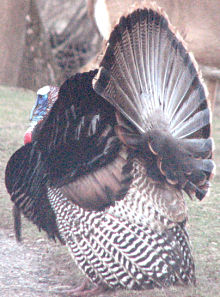Spring Turkey Hunting: Opening Day
In Search of Whitetails 04.25.13

My family has a cabin in north-central Missouri where we stay occasionally. There are thousands of acres of public land nearby, but all I care about is a 50-acre section of wooded ridges where I know the turkey population pretty well. Two years ago, I watched a pair of gobblers strutting for their hens. Last year, I bumped a few birds off of their roost trees. This year I hoped to get a crack at them during the spring turkey hunting season.
Locating birds at night
On the even of opening day, once the kids were in bed and twilight was falling, I took my Primos Hoot Flute and GPS out for some bird-locating. My idea was to locate the gobbler in his roost tree so I’d know where to set up. By the time I reached the treeline, it was nearly dark and only a sliver of moonlight shone. The moment my boot crunched the first patch of dry leaves, a loud snort and the sound of large animals crashing through the trees nearly made me need a change of pants. It was a group of deer; I knew that intuitively from the blowing noise they made, but the sound of something that big and loud that close by had me gripping the handle of my hunting knife even so.
Working my way as quietly as possible through dry leaves down the hill, I started hitting the owl call. Who-cooks-for-you? Who-cooks-for-you-all? Nothing. Not so much as a cluck, and certainly not the shock gobble I’d hoped to hear. From what I knew, the birds I was after tended to roost in trees at the bottom of the hill, about 1/4 mile from the treeline. Imagine my surprise when two of them exploded out of trees to my right, nearly at the top of the hill. They bugged out silently and flew south, probably across the river.
Now, I’d learned my lesson a couple of years before: often a couple of birds will fly out, but others will still remain on roost. Two had gone; I guessed them to be hens because they were roosting so close together. So I figured that, come sunrise, a gobbler would come looking for them and find me instead. I backed out and returned to the cabin to re-check my gear one last time, and get to bed early.
Morning turkey hunt
I set two alarms that would have me up at 5 a.m., an hour and a half before sunrise. Through the night, I kept waking up, wondering if it was time to leave, only to find it was still hours away. Then somehow I slept through both alarms and got up at 6. Damn. The sky was brightening already, so I threw on my gear and hustled down the road.
 I was just wondering if it was too late to use my Hoot Flute when I heard an owl call—a real one—and saw its maker sweep silently past to perch on a tree beside the road. Pale, silent, and well over a foot tall, it watched me approach before gliding away down the road. It was one of those majestic moments that makes you grateful to be a hunter.
I was just wondering if it was too late to use my Hoot Flute when I heard an owl call—a real one—and saw its maker sweep silently past to perch on a tree beside the road. Pale, silent, and well over a foot tall, it watched me approach before gliding away down the road. It was one of those majestic moments that makes you grateful to be a hunter.
Almost forgot to mention this: it was raining, a steady, soaking rain that quickly had me cold and wet. I knew right from the start that this day wasn’t going to be easy. The only plus side of rain is that it soaks the leaves, muffling the sound of my footsteps.
I reached the river and turned west, slipping along just outside the treeline. Now and then I stopped to hit the Hoot Flute. A gobbler answered loudly, but he was across the river. I’ve read that most toms won’t cross water to find any hen, and I think this was the case here. Instead, I reached my planned setup location, a small clearing between two wooded ridges. I set out two decoys — a hen and a jake — in the open, not far from where I’d seen toms strutting back in the fall.
Unfortunately, there were no gobblers in residence, so I moved around the ridges, calling occasionally, looking for birds or sign. At around 8:30 I heard the sharp crack of a stick breaking. Nothing, and I mean nothing, that actually lives in the woods makes a noise like that, so I knew what I was dealing with: other hunters. Specifically, a young couple headed out a leisurely 8:30 to do some turkey hunting. They were wearing hunter-orange caps, which I applaud. Safety’s critical on public land. I let them pass and watched where they headed, then set out in the other direction.
Turkey roost trees
I said I had a good idea of the roosting area, and moving back across the top of the ridge, I confirmed it. Beneath one of the largest, oldest trees (one with big thick boughs) I found piles of turkey droppings — a dozen or more in each spot. Clearly, these are permanent roosts used again and again.
Two piles were about 15 paces apart, in different large branches of the same tree. These were about 40-50 yards from the other two birds I’d jumped the night before, and about the same area as I’ve seen them roosting in previous years. This seems to be an established turkey flock, I’d say 5-6 mature birds at least.
Late-morning gobbler
So these turkeys had roosted here, and they had to have gone somewhere. Based on the roosting grounds, the route I’d taken so far, and the other hunters, I’d eliminated south, north, and west. East was the only thing left, so I began working my way through the thick timber in that direction. Finally, I caught a break: a gobbler sounded off at around 11:00 a.m. At first he was north of me; as I snuck up that way, it seemed like he was moving west. Then he sounded off from down the hill and I thought I had a chance to call him. I was too nervous to try moving any closer.
I slouched against a tree about as wide as my shoulders. Full camo head to toe, including face mask. My shotgun rested on one knee, and I checked aim down the barrel. This was serious. Then I called to him with a couple of yelps, but he couldn’t care less. Only occasionally might I get a gobble, and I think that was just the tom being a tom. Then I tried a purr — a call that I’ve been practicing on my Knight & Hale Tom Coffin — and that got a response. Sort of a, “How dare you feed contentedly when I’m gobbling at you!?” Occasionally I’d purr some more, and he’d gobble back.
At this point it was on the verge of becoming a dialogue, and that wasn’t what I wanted. So I switched to a diaphragm call — not my most confident call, but I wanted to give the illusion of multiple hens. Just a couple of yelps with it was enough to get the gobbler moving. That was the good news. The bad news was that he moved back east, not right to me and the line of my shotgun. Now I was working both the Tom Coffin and the diaphragm cutter.
He came. Out of the corner of my eye, I spotted movement. A red-and-blue head. I could only see it with my non-dominant eye, and went cross-eyed trying to get a look at him. Slow as molasses I turned to look at him. He was in full strut, facing right at me, 50 yards out and craning his head for a look. Whatever he saw, he didn’t like. I think he made me. The fan closed, the turkey said “Puck, puck” and ran off in the other direction. Sigh.
It was nonetheless a thrilling and educational encounter, and I hope to get out in the turkey woods again soon!
This article originally appeared on In Search of Whitetails and is republished with permission.


